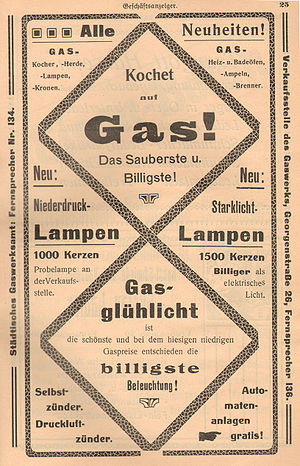Eisenach gas works
The Eisenach gas works is a former gas production facility and is now a ruin in the Wartburg city of Eisenach in Thuringia .
The development of the Eisenach gas supply
Gasworks Wörthstrasse (1857–1899)
After the Deutsche Continental-Gas-Gesellschaft made the first offer to set up a gas station in Eisenach in 1857 and gas had become widely used as a means of lighting at the beginning of the 1860s, the Eisenach gasworks went into operation on October 1, 1862. On October 1st, the retort furnaces in Wörthstrasse (Karl-Marx-Strasse) were heated. The maximum delivery was 1,350 m³ hard coal gas per day. The first gas tank held 650 m³. In the same month, the sale of oil and photogenic lanterns started and on October 23 the first gas lamp was installed. But soon there were over 150 gas lamps and 1,000 private flames were burning in Eisenach. The oil lanterns quickly disappeared from the streets. In 1863, 104,080 m³ of town gas were already being produced. The number of 16,480 meters, which was determined in 1884 as the length for the pipe network for the gas supply, testifies to the rapid development of the town gas network in the following years.
As early as 1893, the main distribution pipe had to be expanded from DN 175 to DN 300. In Wörthstraße, a DN 200 line had to be laid parallel to the original line (DN 175) in order to ensure that the gas was discharged as required.
Further expansion of the network followed in line with the increasing demand for town gas. The output of the gasworks was increased by extensions to a daily output of 5,000 m³ by 1897, the gas container size was 2,500 m³. The productivity was strained to the utmost and was around 1,260,220 m³ / a. Due to the existing structure immediately next to the embankment, no further expansion was possible. That is why the gas works in Wörthstrasse was shut down in 1898.
New construction of Gaswerkstrasse
Construction of a new gas plant in the west of the city began as early as the spring of 1898. It had its own siding for coal transports. In the first stage of construction, five horizontal retort furnaces (three 9-series, two 6-series) produced a daily output of 5,000 m³. A main line of the new gas works was moved to Alexanderstraße with a nominal width of DN 400, from where the network branched out further. In 1901 more than 1.5 million m³ of town gas were produced. The network was expanded again and efficiency increased. Due to pressure fluctuations, pipelines were constantly changed and new lines laid. The introduction of "cooking gas" in 1910 led to the expansion of the plant to double the capacity. At that time, 15,000 m³ / d were initially produced, which corresponds to an annual output of 2.6 million m³. Gas consumption had quadrupled between 1888 and 1912. While the emission of luminous gas almost came to a standstill during this period, the consumption of heating and cooking gas increased by a factor of 120 and in 1910 reached a value of 1,118,039 m³. Coin gas meters were introduced, after inserting a coin the customer could briefly take gas for cooking and heating purposes, depending on the gas price. In 1911, 176,000 m³ of gas were consumed by the population with these coin-operated machines, and in 1912 more than 1,000 such machines were installed in households, especially in small rental apartments. In 1912 there were a total of 938 public lantern flames in Eisenach, including single and multiple gas incandescent lights, so-called "Luke lights" and "Pharoslapen". There were still 5 oil lamps in the suburbs. The focus was on the first electric arc lamps. The street lighting cost 46,600 marks, which is equivalent to 1.20 marks per inhabitant annually. 150 gas lanterns have already been remotely ignited and extinguished from the factory this year, which saved considerable costs for lantern guards. 300 street lamps were still under construction.
Current situation
The Eisenach gas works ceased operations in 1982, the technical systems were worn out. The location on the outskirts, with a siding, was favorable for relocating the coal trade. This used the site until 1990 as an unloading and reloading station for coal trains. With the expansion of the long-distance gas network and other energy sources, the demand for coal as a fuel in Eisenach fell sharply, and coal trading was discontinued. As an industrial ruin, the factory premises represent a redevelopment area, preliminary investigations showed:
“... that the soil is highly polluted with phenols and aromatic hydrocarbons . As a result, there is little room for maneuver for the subsequent use of this site. A residential development, for example, is ruled out - because no one can afford a corresponding renovation. It would be possible to build a parking lot on the spot, possibly also to set up a new fairground ... "
At the beginning of 2018, they began demolition work on the site, which will go hand in hand with the remediation of contaminated sites.
literature
- Walter Hermann: The Eisenach industry. Part VII: "The new gas company". In: Eisenacher Tagespost. No. 261 (November 6, 1903)
- Gerd Bergmann: «Gaswerkstrasse» - Eisenacher street names . In: Eisenach writings on local history. Volume 44, Eisenach 1990
Web links
Individual evidence
- ↑ NN: The owners should pay. Topic remediation of contaminated sites in Eisenach . In: Hessische / Niedersächsische Allgemeine (Hrsg.): Mitteldeutsche Allgemeine. Eisenach district . Eisenach September 28, 1993.
- ↑ Demolition work on the former gas works begins , press release of the City of Eisenach from January 12, 2018, accessed on December 3, 2018
Coordinates: 50 ° 58 ′ 39.1 ″ N , 10 ° 17 ′ 58.7 ″ E

